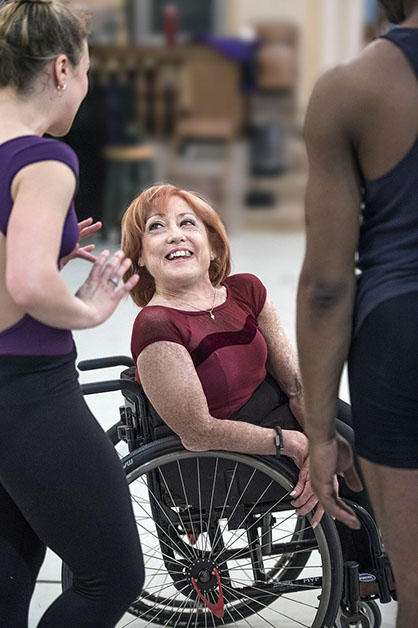Mary Verdi-Fletcher
2016 LIFETIME ACHIEVEMENT PRIZE IN THEATRE & DANCE
When Mary Verdi-Fletcher was born, doctors informed her parents she wouldn’t live beyond three. Instead, age three was when Mary decided she wanted to dance. The fact she was born with a disability that put her in a wheelchair at age 12 wasn’t going to stop her. Indeed, it hasn’t stopped her from doing, well, just about anything she’s wanted to do, from becoming the first professional wheelchair dancer in the US to founding her own company, Dancing Wheels.
Fortunately, her father was a saxophone player in orchestras and her mother a Vaudeville dancer, so she was always surrounded by music and movement. Moreover, her mother regularly stretched and exercised her baby daughter’s leg muscles. As a child, Mary would play Ginger Rogers to her brother’s Fred Astaire in elaborate dances her mother staged for them in their family room.
“My parents fostered that love of art within me,” Mary reflects. “But our communities weren’t accessible or knowledgeable about the capabilities of people with disabilities, so there was no place for me to train as a wheelchair user.”
However, that didn’t keep Mary from discovering that disco dancing was an ideal medium for wheelchair spins, turns and glides. So what else would she and her dancing partner do but enter the “Dance Fever” national television competition? She didn’t mention her disability in the application, so the nearly 2,000 audience members were stunned into silence when she rolled on stage at the Cosmopolitan Club in Willoughby. Set to The Weather Girls’ song “It’s Raining Men,” their rollicking routine included a flip off the armrests of Mary’s wheelchair by her gymnast partner.
“People jumped to their feet and applauded, and the producer from California threw himself back in his chair because he was astounded,” Mary recalls. “Even though we showed a small kernel of possibility, it was the beginning, and that was the day we named it Dancing Wheels.”
Although Mary was working full-time helping people with disabilities at an independent living center, she and her partner found time to travel the country to give 72 performances in one year. She negotiated a deal with her husband Bob that she would have one year to establish her own non-profit dance company. She founded Dancing Wheels in 1980 and became affiliated with the then Cleveland Ballet, where she continued her own training.
Dancing Wheels took on momentum and burgeoned into a successful organization. Today, working out of their 7,000-square-foot studio/office space in the Masonic Performing Arts Center, the company of 14 full-time dancers continues to give 70 to 90 performances a year nationwide and, in keeping with its strong educational message, works with 6,500 children a year in Greater Cleveland and Akron schools.
“What she’s accomplished is an incredible feat for anybody, regardless if they have a disability or not, to sustain a dance company for 35 years,” says Mark Tomasic, professor of dance at Santa Monica College and Artistic Advisor to Dancing Wheels who has worked with Mary since 1994. “I’ve never worked with anybody who’s been more tenacious and determined to advance their message.”
To date, Mary has performed in 60+ ballets and repertory works, including lead roles in “The Snowman” choreographed by Sabatino Verlezza and “Alice in Wonderland” choreographed by Robert Wesner, and a featured role in “Sweet Radio Radicals” choreographed by Dianne McIntyre(CAP 2006). As a dancer/choreographer and Artistic Director, Mary’s artistry and message of inclusion are beautifully intertwined in a work created for Dancing Wheels: “Walking with Clouds” by David Rousséve. In one movement, Mary performs her story as a wheelchair user wanting to ride the bus in Cleveland. In 1985, she participated in a landmark protest to obtain wheelchair accessibility on RTA buses.
She has written for several major publications; written, produced and directed two made-for-TV documentaries; and won numerous awards, including a Governor’s Award for Arts Education in Ohio and Ohio Dance Award for major contributions to dance in Ohio in 2014.
Currently, Mary has turned her long-established advocacy toward encouraging colleges and universities to offer disabled students dance degrees. She is also actively promoting physically integrated dance throughout the US and the world to bring down remaining barriers for disabled artists.
“I always encourage people to investigate Dancing Wheels more deeply,” says Mary, who was profoundly touched by receiving a Cleveland Arts Prize. “If you think we’re only for people with disabilities, we’re not. We are completely integrated and diversified. So we want everyone to understand the full depth and breadth of our organization.”
Cleveland Arts Prize
P.O. Box 21126 • Cleveland, OH 44121 • 440-523-9889 • info@clevelandartsprize.org